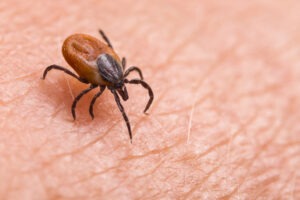What to Do After a Tick Bite: Symptoms, Prevention & Testing
According to data posted by the CDC, tick bite frequency is steadily increasing. May 2025 marked the peak of this year so far, with 134 people visiting the emergency room for tick bites. The risk of contracting Lyme disease ranges between 0% to 50%, since not every tick has Lyme.
According to CDC data, the risk of getting Lyme in Wyoming is almost zero. That said, Massachusetts and New York are hot spots for the disease. Surveys published in the New York Times also show that many residents in Lyme-infested areas don’t even use tick repellent.
It is important to take the proper steps after a tick bite to prevent or address Lyme infections. This article will offer some insight into how to do that.
Immediate Actions to Take After a Tick Bite
Careful removal of the tick is the most important thing to do. Incorrect removal ends with the mouthpiece remaining stuck in the skin. While the head itself cannot transmit Lyme disease, it increases the chances of infection.
To prevent potential complications, remove the tick as soon as you discover it.
How to Safely Remove a Tick
Ticks should be removed properly, ideally from the first few moments of attachment. The risk of Lyme disease increases as more hours pass. This is why it should be removed before 36 hours.
Here is the technique:
- Use Fine-Tipped Tweezers. Grab the tick as close to the skin as possible.
- Pull Upward. Don’t jerk or twist the tick, as it causes parts of it to break off.
- Clean the Area. Use rubbing alcohol or soap and water to sanitize the area.
- SAVE THE TICK: Send it in for testing. Tick Check or Igenex are great labs.
- Get Tick Treatment. Consider herbal therapy, nutrition changes, and other naturopathic recommendations for Lyme, if necessary. We have an acute child and adult tick page that can be found here.
- Steer clear of folk remedies for tick removal, such as burning the tick or twisting it. This irritates the tick rather than killing it. As a result, it could end up releasing more pathogens in the body, including for Lyme disease.
Does the Tick Need to Be Attached for 24 Hours to Spread Lyme?

The tick doesn’t have to be attached for 24 hours to spread Lyme. Indeed, this is the most common timeline, but the Borrelia bacteria can enter the bloodstream sooner. This depends on what feeding stage the tick is in. Sometimes, it takes longer. Other times, it happens faster. Understanding the transmission helps prevent Lyme infection.
Why This Common Claim Is Misleading
The CDC claims that Lyme disease needs an average of 36 to 48 hours to spread after the initial bite. Recent studies dispute that myth, as certain circumstances cause the disease to spread sooner. Longer tick attachment increases the risk, but shorter timeframes don’t eliminate it entirely.
Research by Michael J. Cook on Lyme Borreliosis shows that infection time is as short as 16 hours. While these incidents are isolated, Lyme spreads if the tick starts transmitting the bacteria sooner.
The body’s natural immune system is made to protect itself from these pathogens. However, after it attaches to the skin, the tick’s salivary proteins begin suppressing the immune system. This creates a path for the Borrelia bacteria to enter the bloodstream.
A tick infects quickly if you have a weakened immune system, as the pathogens have a clear path. If the tick ate before attaching itself to you, it starts releasing saliva and bacteria sooner. That’s because the tick is already full enough to regurgitate pathogens and saliva.
Some ticks could have co-infections such as Anaplasma, Rocky Mountain Spotted fever, Bartonella, or Babesia. The tick infects patients quickly with these pathogens, sometimes within minutes.
Should You Take Antibiotics After a Tick Bite?
The CDC would say there’s no need to take antibiotics after a tick bite and that Lyme disease rarely has time to go into your bloodstream in the first couple of hours, so taking antibiotics is unnecessary.
However, some doctors recommend a single dose of antibiotic, especially if the tick is discovered late.
In my experience…
Even if the tick is not attached at all or for long, I have seen patients still end up with Lyme Disease. This is why I watch the patient closely and may give them prophylactic anti-microbial herbs and immune support. Listening to the patient, their symptoms, and running appropriate labs will help grant the patient with the best treatment.
What Mainstream Guidelines Say
The CDC recommends a single dose of doxycycline if it’s within the approved window. The normal prophylactic treatment dosage is 200 mg for adults or 4.4 mg/kg for kids. Studies posted on Oxford Academic by Grace E. Marks in 2024 show that taking prophylactic antibiotics decreases the risk of Lyme by 87%.
Below are some situations when a naturopath may recommend the administration of prophylactic medicine:
- The tick that bit you was from the blacklegged species
- The tick was discovered later than 36-72 hours after contact
- The tick bite happened in an area that’s a hot spot for Lyme disease
- You removed the tick at least 72 hours ago
- You are not pregnant or allergic to doxycycline
- You are at least 8 years old
Should these circumstances be met, many doctors prescribe the treatment. Patients choose whether they take or decline the treatment. However, if there aren’t any symptoms and the conditions aren’t met, the doctor probably won’t prescribe any antibiotics.
Unnecessary use of antibiotics leads to a series of complications, such as the disruption of the gut microbiome. Studies developed by the CDC also suggest that unnecessary use of doxycycline leads to antibiotic resistance. This affects some 30% of patients who took the antibiotic incorrectly.
Why Antibiotics Aren’t Always Enough
A single dose of antibiotic is not always enough to prevent the symptoms if the Borrelia bacteria have had enough time to spread.
The drug also proves ineffective if co-infections are present. This happens because the treatment is not strong enough to handle multiple infections.
Depending on the circumstances and the status of your immune system, symptoms take weeks to show up. This leads to misdiagnosis and incorrect treatment.
To add even more fuel to the fire, early Lyme disease can end up with false negative tests. This is common with slow immune systems, as they have not produced antibodies yet. This leads conventional doctors to dismiss important symptoms.
Depending on the situation, Lyme disease can turn into Post-Treatment Lyme disease. According to studies published by the Johns Hopkins Medicine Lyme Disease Research Center, this condition affects 14% of those infected with Lyme, especially those who received poor treatment.
Naturopathic Protocols to Support Your Body After Exposure
Naturopathic protocol focuses on supporting the body with natural remedies after potential exposure to Lyme disease. Antibiotics may be administered, if necessary, but your natural defenses were made to fend off infection. This reduces the chances of developing Lyme disease and helps you recover.
Immune System Support After a Bite
Immune system support should begin immediately after a tick bite. Naturopaths describe herbal antimicrobials such as:
- Vitamin C: Supports tissue repair.
- Cat’s Claw: Offers inflammation modulation properties.
- Andrographis: Helps support the immune system while offering an antimicrobial effect.
- Medical Mushrooms: Cordyceps or reishi mushrooms offer immune support.
- Astragalus: Used in early Lyme treatment to improve the functions of the immune system.
When administered correctly, these herbs offer immune modulation without suppressing the response. This way, the immune system defends against bacteria, creating the appropriate antibodies.
You can also view our Acute Adult and Child Tick Pack on our website https://naturallysue.com/supplements-packages/.
Natural Antimicrobial Strategies
Low-risk patients with no access to immediate antibiotics could try natural medicine to reduce disease progression. This is most effective for patients who have no symptoms and missed their 72-hour window for doxycycline.
Common botanical protocols to treat Lyme disease include one or more of the following herbs:
- Japanese knotweed
- Cat’s claw
- Black walnut
- Teasel root
- Artemisinin
- Chinese Skullcap
You must work with a naturopath, as no treatment is a one-size-fits-all. They create a plan based on your symptoms, exposure level, and constitution, even on the phone.
Watch for These Symptoms in the Days and Weeks After a Bite
Symptoms of Lyme disease appear several days or weeks after the bite. This includes a rash, flu-like symptoms, swollen lymph nodes, and more.
It’s Not Always a Bullseye Rash
The erythema migrans (or bullseye) rash is the most common symptom of Lyme. It looks exactly like its nickname: a larger circular patch with a central clearing, like a target. However, not everyone gets this rash.
According to CDC records published in 2024, an average of 20-30% of patients don’t present an erythema migrans (bullseye) rash.
Some people get rashes, but they look different from the bullseye. This includes:
- Oval or irregular shape
- Multiple rashes
- Solid red rash without a clearing
Patients frequently misread these rashes if they cannot find the tick. This leads to them receiving incorrect treatment.
Non-Rash Symptoms to Track Early
Patients also experience flu-like symptoms in early Lyme infections. These frequently include the following:
- Body aches
- Fever
- Swollen lymph nodes
- Fatigue
- Cognitive problems
Should these symptoms emerge, it’s best to keep a journal and report anything odd. Patients should monitor their condition to minimize Lyme symptoms.
What If You Start Feeling Off Weeks Later?
Symptoms that appear weeks after the bite should not be ignored. Sometimes, Lyme comes with a delayed onset. Early treatment is essential to reduce complications.
Getting Tested — What to Know
The CDC approved ELISA and Western blot testing for Lyme disease. Timing is important, as both treatments rely on your immune response.
Early testing could miss the infection because the body hasn’t produced sufficient detectable antibodies. The infection sometimes hides in the tissue, which is why testing should be repeated within four to six weeks after exposure.
Don’t Wait for a Rash or Positive Test to Seek Help
Rashes don’t always appear with Lyme disease. Similarly, a negative test doesn’t automatically mean you don’t have Lyme. If the clinical presentation suggests there’s something odd, seek help.
Naturopath doctors evaluate your condition and offer a potential Lyme diagnosis, despite the condition being misunderstood. Patients should advocate for their condition, even if conventional testing is inconclusive.
FAQs: Tick Bite Misconceptions
1.Do All Ticks Carry Lyme?
No, only some tick species are known to carry Lyme. The most common is the blacklegged (deer) tick, also known as Ixodes scapularis. These ticks carry Borrelia Burgdorferi in high-risk areas.
2.Can You Get Lyme from a Nymph Tick?
Yes, Nymph ticks can also carry Lyme disease. Since they are the size of a poppy seed, they often go unnoticed. A longer attachment duration increases the chances of contracting the disease.
3.Do You Need a Rash to Have Lyme?
No, you don’t need a rash to have Lyme. Up to 30% of patients don’t even get a rash, causing them to be misdiagnosed.







